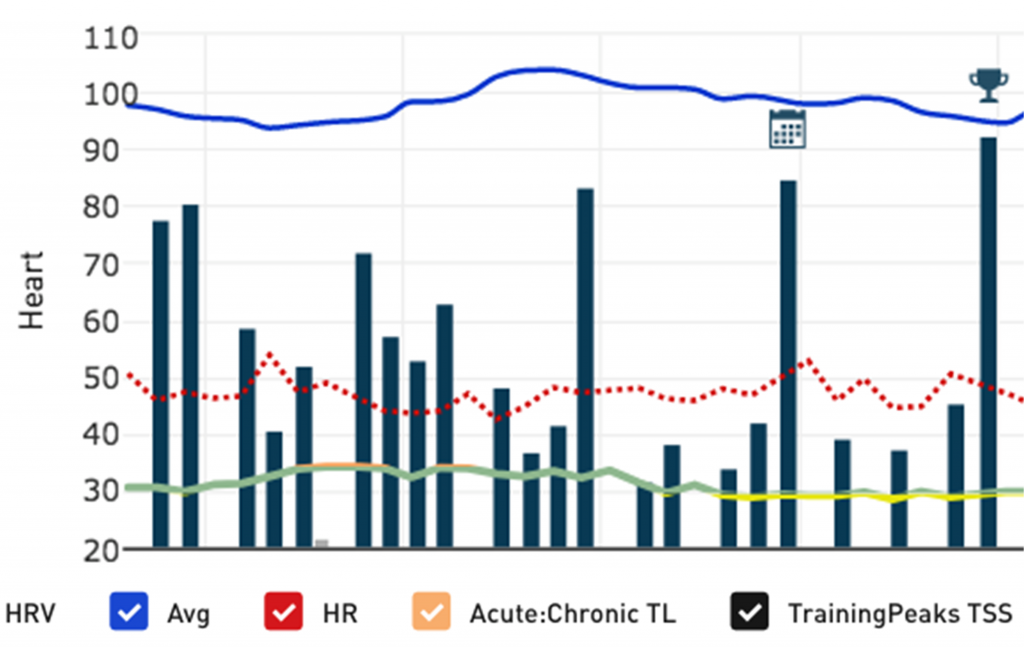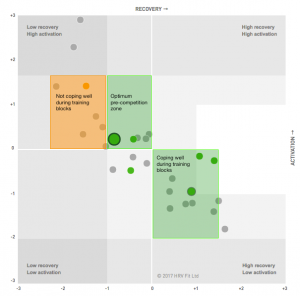You’ve done the training and logged the miles – so how do you ensure your taper is on track to deliver the best possible performance on the big day?
In this article, we’re going to show you how you can use the metrics and tools in ithlete Pro to manage your taper before an important race or competition.
1. Reduce Training Load gradually
Assuming you have synced your ithlete Pro account with either Garmin Connect or TrainingPeaks, you can use the Acute:Chronic training load ratio to regulate how fast you reduce the load.
The ithlete Pro timeline chart below shows a great example. Daily Training Loads are high, with peak TSS around 200 until 14 days before the competition event (flagged on the right hand side of the chart). During the more intensive training phase, the Acute:chronic line is green, but on the boundary of orange, showing that loads are at the upper end of the low injury risk range. During the last 2 weeks, days of complete rest are interspersed with daily loads of 60-75 TSS, save for a minor race one week out (TSS 220). The Acute:chronic line is green bordering on the yellow, which indicates loads are being preserved just high enough to prevent detraining over the short term. It’s important to maintain some intensity during this phase, so that the sympathetic (fight or flight) branch of the nervous system remains responsive.

Look for the daily dot on the Training Guide to move upwards and left
During periods of heavy training loading you can expect your HRV to be higher than usual, and your resting HR to be lower. The reasons for this are likely to be due to the body producing or becoming less sensitive to fight and flight hormones such as adrenaline and cortisol, which are being heavily demanded during this time.
The chart below (taken from this post all about the Training Guide chart) shows HRV (Recovery) a little above normal, and HR (Activation) below normal in when the athlete is coping well during a training block.
As training loads are reduced, the daily dot should move upwards and leftwards as HRV decreases and resting HR increases, signifying that fight or flight responses are getting back to normal. You may well notice your exercise HR rises more rapidly when you train, reflecting this increased freshness.

Look for HRV to drop and resting HR to rise on the Timeline
You can see these trends in the Timeline chart above too: the HRV weekly average (blue line) builds to the end of the intense training period, then decreases during taper (note that the minor race increases it again slightly, before it resumes the downwards trend). The trend in the resting HR is not so easy to see with this athlete, who has a low resting HR of 45-50 bpm.
Take care of the three recovery enablers
During the taper phase, it is especially important that you pay attention to the main factors influencing recovery:
- Sleep
- Diet & nutrition
- Stress management
The better the job you do of these, the more recovered you will be come to race day. The Simon Says AI will feed back how well you are doing with these!
Don’t record HRV on race day itself
On the day of the race, we would recommend you don’t take a reading. Pre-event nerves and unfamiliar surroundings combined with an early start are likely to increase your resting HR, and reduce your HRV, and you don’t want to be put off by an amber or even red HRV warning, caused by your fight or flight response being activated in anticipation. Don’t worry though – these will not affect your performance on the big day!
